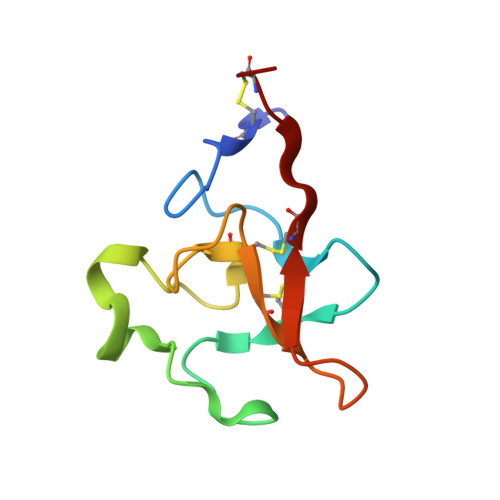Human plasminogen kringle 3: solution structure, functional insights, phylogenetic landscape.
Christen, M.T., Frank, P., Schaller, J., Llinas, M.(2010) Biochemistry 49: 7131-7150
- PubMed: 20617841
- DOI: https://doi.org/10.1021/bi100687f
- Primary Citation of Related Structures:
2L0S - PubMed Abstract:
Human plasminogen kringle 3 (hPgn K3) domain contains most elements of the canonical lysine-binding site (LBS) found in other Pgn kringles. However, it does not exhibit affinity for either lysine or structurally related zwitterionic ligands. It has been shown that lysine-binding activity can be engineered via a Lys57 --> Asp mutation [Burgin, J., and Schaller, J. (2009) Cell. Mol. Life Sci. 55, 135]. Using a recombinant construct expressed in Escherichia coli, the three-dimensional solution structure of hPgn K3 was determined via NMR spectroscopy [heavy atom averaged rmsd = 0.35 +/- 0.07 A (backbone) and 0.75 +/- 0.12 A (all)]. The (1)H/(15)N heteronuclear single-quantum correlated (HSQC) spectra for both wild-type K3 and mutated [r(K57D)K3] structures are essentially identical, implying that the two structures are effectively isomorphous. The affinity of r(K57D)K3 for the lysine analogue trans-(aminomethyl)cyclohexanecarboxylic acid (AMCHA) was investigated from ligand-induced NMR chemical shift perturbations, which enabled for mapping the binding site on the mutated domain surface. The equilibrium association constant, K(a), was determined to be approximately 5.23 +/- 0.03 mM(-1). Homology modeling combined with in silico docking of lysine-like zwitterionic ligands via AutoDock 4.0 supports functionality of the engineered (K57D)K3 LBS, whose electrostatic focal centers are defined by the Arg36/Arg71 cationic and Asp55/Asp57 anionic pairs. Comparison of K3-type sequences from different vertebrates, including kringles from hedgehog apolipoprotein(a) [Apo(a)] and Apo(a)-related (Arp) sequences, reveals that Lys57 is confined to the hPgn variant. Based on the likely phylogeny and ligand affinities of the homologous domains, it is suggested that the hPgn K3 is unique in that all other K3-type domains, including hedgehog Apo(a) and all Arp domains, except K3(1), are predicted to variously exhibit lysine-binding capability. In Arp K3(1) an Arg residue fills site 72, replacing the key aromatic residue found in other kringles, thus interfering with a requisite kringle-ligand hydrophobic interaction.
- Department of Chemistry, Carnegie Mellon University, Pittsburgh, Pennsylvania 15213, USA.
Organizational Affiliation:
















